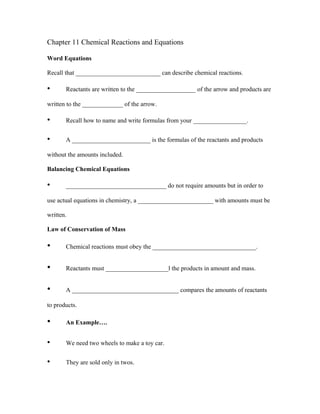
Chapter 11 note taking guide
- 1. Chapter 11 Chemical Reactions and Equations Word Equations Recall that ___________________________ can describe chemical reactions. • Reactants are written to the ___________________ of the arrow and products are written to the _____________ of the arrow. • Recall how to name and write formulas from your _________________. • A _________________________ is the formulas of the reactants and products without the amounts included. Balancing Chemical Equations • ________________________________ do not require amounts but in order to use actual equations in chemistry, a ________________________ with amounts must be written. Law of Conservation of Mass • Chemical reactions must obey the _________________________________. • Reactants must ____________________l the products in amount and mass. • A __________________________________ compares the amounts of reactants to products. • An Example…. • We need two wheels to make a toy car. • They are sold only in twos.
- 2. • Each toy car has one car body (Cb) and 4 wheels are necessary. (W4) • What would be our balanced chemical equation for the toy car? Building a Tricycle…. • Again, we need one trike body (Tb) but a tricycle has 3 wheels (W3) and the wheels only come in packages of two. (W2) • How many orders of each tricycle should be make so there are no leftover parts? • Write a balanced “chemical” equation. Tips and Tricks… • If there is a ____________________________ on both sides of the equation, keep it together and balance it as one atom. • Balance the more ________________________ compounds first. • The elements that are by themselves should be balanced last. • Sometimes it is helpful to create a _________________ below the equation to keep track of the numbers. • If you have a word equation, write the ____________________________ first, then balance. LET’S PRACTICE! • Balance the equations.
- 3. • AgNO3 + H2S Ag2S + HNO3 • Zn(OH)2 + H3PO4 Zn3(PO4)2 + H2O • Iron(III) chloride + calcium hydroxide iron(III) hydroxide + calcium chloride Types of Chemical Reactions • There are ________ general types of reactions. • Occasionally, a reaction may fit equally into __________ categories. • ____________________ is useful to help determine and predict the products. Combination Reactions • It is also called a ______________ reaction. • ________________________ substances combine to create a _______________ new substance. • Mg + O2 MgO • K + Cl2 KCl • Balance these equations!
- 4. Draw a picture example of a combination reaction. Decomposition Reactions • A ______________ compound breaks down into ___________________ simpler products. • HgO Hg + O2 • H2O H2 + O2 • Balance these equations! Draw a picture example of a decomposition reaction. Single-Replacement Reaction • One element ________________ a second element in a compound.
- 5. • Requires the ________________________ to determine if the reaction will occur. • The element that is ___________________ on the series will replace any lower elements. • A ___________________ (group 7) can replace any other halogen providing that it is higher up on the periodic table. • If a reaction doesn’t occur, write _____________ for no reaction. Single-Replacement Reactions
- 6. • K + H2O KOH + H2 • Zn + Cu(NO3)2 Cu + Zn(NO3)2 • Br2 + NaI NaBr + I2 • Br2 + NaCl NR • Balance these equations! Draw a picture example of a single-replacement reaction. Double-Replacement Reactions • Sometimes when two solutions are mixed, ____________________________. • Other times, the _____________ in the two solutions react. • In these types of reactions, the two ______________ (positive) cations _______________ places with each other. • Occasionally, a ________________ will form or a gas will be generated. • Sometimes, both products are _________________ so you won’t see anything different Double-Replacement Reactions • Na2S + Cd(NO3)2 CdS + NaNO3
- 7. • NaCN + H2SO4 HCN + Na2SO4 • Ca(OH)2 + HCl CaCl2 + H2O • Balance these equations! Draw a picture representing a double-replacement Reaction. Combustion Reactions • This is a chemical change that takes place when a compound (usually a hydrocarbon) reacts with ________________ and produces _________________, _______________ and usually ____________________ in the form of heat and/or light. • C8H18 + O2 CO2 + H2O • When balancing, these numbers are usually high. Draw a picture showing a combustion reaction. Reaction in Aqueous Solution
- 8. • Your world is water-based. • Most reactions take place in _______________. • Most equations can show the reactions between compounds but do not show how the compounds _________________ when dissolved in water. • They actually separate into the __________________________ when in aqueous solution. • You can use these ions to write a _________________________. • If the ion remains ________________ on both sides of the equation, it is called a _____________________. • The ____________________ doesn’t participate in the reaction directly and can be _______________________. • The resulting equation is called the ________________________. • Remember, the resulting equation must be ________________________. Net Ionic Equations • A net ionic equation shows only those ___________________ involved in the reaction and is balanced with respect to both ______________ and _______________. • Pb (s) + 2Ag+ (aq) 2Ag (s) + Pb +2 (aq) • There are 2 Ag on both sides and +2 on both sides. Solubility • _______________ means it can dissolve in water or be _________________. • There are rules to determine if something is soluble or not. • Page. 344 table 11.3 has the rules.
- 9. • If something is soluble write _____________ • If it isn’t soluble or is insoluble, it is solid or _____________ • Check the table for the rules. LET’S PRACTICE! • Balance this equation. • Ca+2 + OH- + H+ + PO4-3 Ca+2 + PO4-3 + H2O LET’S PRACTICE! • Write the complete and net ionic equations for:
- 10. • Sodium hydroxide (aq) and phosphoric acid (aq) makes calcium phosphate and water. • Don’t forget to use your solubility rules.
